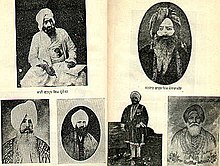
| Part of a series on |
| Sikhism |
|---|
 |
The Singh Sabhā Movement, also known as the Singh Sabhā Lehar,[1] was a Sikh movement that began in Punjab in the 1870s in reaction to the proselytising activities of Christians, Reform movements (Brahmo Samaj, Arya Samaj) and Muslims (Aligarh movement and Ahmadiyah). The movement was founded in an era when the Sikh Empire had been dissolved and annexed by the British, the Khalsa had lost its prestige, and mainstream Sikhs were rapidly converting to other religions.[2] The movement's aims were to "propagate the true Sikh religion and restore Sikhism to its pristine glory; to write and distribute historical and religious books of Sikhs; and to propagate Gurmukhi Punjabi through magazines and media."[3] The movement sought to reform Sikhism and bring back into the Sikh fold the apostates who had converted to other religions; as well as to interest the influential British officials in furthering the Sikh community. At the time of its founding, the Singh Sabha policy was to avoid criticism of other religions and political matters.[3][4]
Singh Sabha was successful in almost doubling the Sikh population by bringing new converts into Sikh fold. Sikhs were traditionally proselytising. Between 1901-1941, many Jats, OBC's, and Dalits converted to Sikhism due to outreach and preaching efforts of Singh Sabha movement. [5][6]
- ^ "SGPC to observe 150 yrs of 'Singh Sabha Lehar'". The Tribune. 5 August 2023. Retrieved 9 August 2023.
- ^ Barrier & Siṅgh 2004, p. 206.
- ^ a b Barrier & Siṅgh 2004, p. 208.
- ^ Editors of Encyclopedia Britannica (2010). "Singh Sabha (Sikhism)". Encyclopædia Britannica.
- ^ Singh, G., & Shani, G. (2021). The Emergence of Modern Sikh Nationalism, 1880s–1930s. In Sikh Nationalism (New Approaches to Asian History, pp. 52-81). Cambridge: Cambridge University Press. doi:10.1017/9781316479940.005
- ^ Census of India, 1931, Punjab, Part I, Report, p. 69 and Census of India, 1941.
